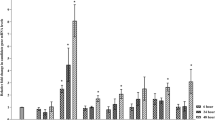Abstract
The resistance ratio ofHelicoverpa armigera to Cry1 Ac insecticidal protein fromBacillus thuringiensis (Bt) is 13.1- and 3.02-fold after 18 generations of selection by transgenic tobacco expressing Bt or two (Bt and CpTI) insecticidal protein genes, in which the average corrected mortality for each selection treatments is about 60%. The mortality of selected population by transgenic Bt gene tobacco is significantly lower than the control strain when fed on transgenic tobacco plants. The mortaltty of the selected population by transgenic two genes tobacco was not significantly different from the control strain. This is the first experiment under laboratory condition which has proved that transgenic two genes tobacco could significantly delay resistance development ofH. armigera compared with one gene.
Similar content being viewed by others
References
Schuler, T. H., Poppy, G. M., Kerry, B. R.et al., Insect-resistant transgenic plants,Trends Biotechnol., 1998, 16: 168.
Zhao, J. Z., Zhao, K., Lu, M.et al., Interactions between transgenic Rt cotton andHelicovrpa armigera in North China,Scientia Agricultura Sinica (in Chinese), 1998, 31(5): 1.
Tabashnik, B. E., Evolution of resistance toBacillus thuringiensis, Ann. Rev. Entomol., 1994, 39: 47.
Zhao, J. Z., Zhu, G. R., Ju, Z. L.et al., Resistance of diamondhack moth toBacillus thuringiensis in China,Resistant Pest Management, 1993, 5(2): 11.
Roush, R. T., Shelton, A. M., Assessing the odds: the emergence of resistance to Bt transgenic. plants,Nuture Biotechnology, 1997, 15: 816.
Gould, F., Sustainability of transgenic insecticidal cultivars: integrating pest genetics and ecology,Ann. Rev. Entomol., 1998, 43: 701.
McGaughey, W. H., Whalon, M. E., Managing insect resistance toBacillus thuringiensis, Science, 1992, 258: 1451.
Zhao, R., Fan, Y.L., Shi, X.et al., Highly insect-resistant transgenic tobacco plants containing both Bt and CpTI genes,Chinese J. Biotechnology (in Chinese), 1995. 11: 1.
Hua, X., Ma, W., Fan, Y. L.et al., Transgenic tobacco by cotransfomtion of proteinllse inhibitor II and δ-endotoxin,Chinese Science Bulletin (in Chinese), 1993, 38(8): 747.
Fan, X., Shi, X., Zhao, J. Z.et al., Insecticidal activity of transgenic tobacco plants expressing both Bt and CpTI genes onHelicoverpa armigera, Chinese J. Biotechnology (in Chinese), 1999, 15: 6.
Tabaehnik, B. E., Resistance risk assessment: realized heritsbility of resistance toBacillus thuringiensis in diamondback moth, tobacco budworm and Colorado potato beetle,J. Econ. Entomol., 1992, 85: 1551.
Author information
Authors and Affiliations
About this article
Cite this article
Zhao, J., Fan, Y., Fan, X. et al. Evaluation of transgenic tobacco expressing two insecticidal genes to delay resistance development ofHelicoverpa armigera . Chin. Sci. Bull. 44, 1871–1874 (1999). https://doi.org/10.1007/BF02886343
Received:
Issue Date:
DOI: https://doi.org/10.1007/BF02886343




